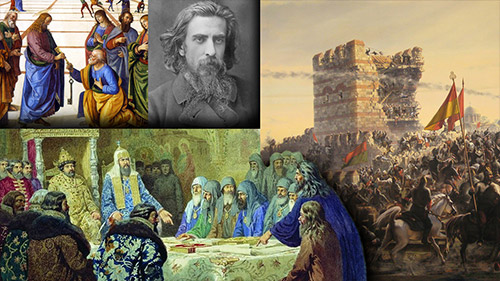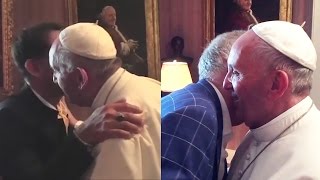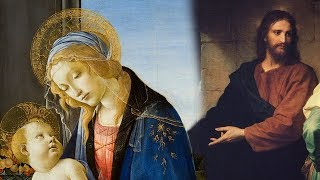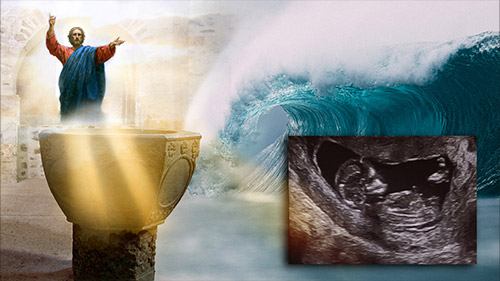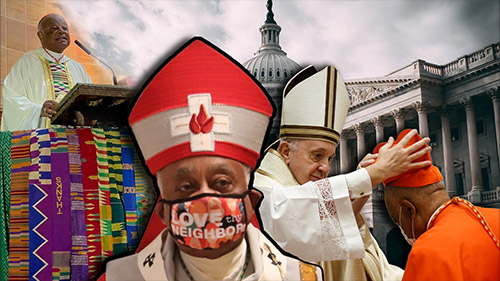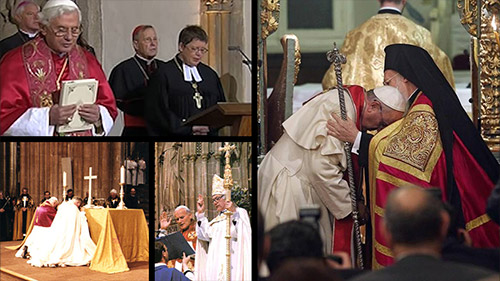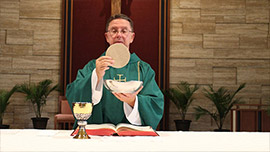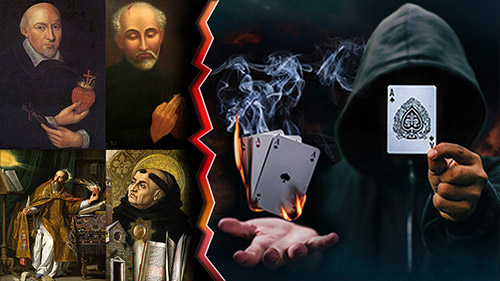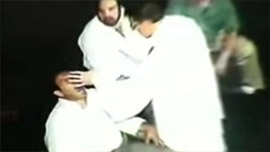 | vaticancatholic.com - English Channel |
Antipope Francis - Why He Is Not The Pope | Faith & Doctrine | Featured Videos | History | Lives Of Saints | The Gates Of Hell Shall Not Prevail | The True Popes Of The Catholic Church | Traditional Catholic Issues | Vatican II Church Is Not Catholic | Where Is The Catholic Church? This video will cover some very important passages that deal with the Catholic Church’s teaching that someone who holds office in the Church, but preaches notorious heresy, loses authority from the moment that he preaches the heresy, even if no declaration has been made against him.
This is relevant to the correct Catholic position in our day, that the post Vatican II claimants to the Papacy are heretical antipopes and that the Chair of St. Peter is vacant (often referred to as the sedevacantist position). The passages we will focus on come from Pope St. Celestine in regard to the heretic Nestorius, and the principle we will cover applies not only to loss of office for heresy but also to how heresy impedes the assumption of office. Nestorius was the Bishop of Constantinople. He was condemned as a heretic at the Council of Ephesus in 431 for denying that Mary is the Mother of God and for contradicting the truth that Jesus Christ is one divine person. Our Lord is, of course, one Divine Person with two natures. St. Cyril, Bishop of Alexandria, opposed and refuted Nestorius. Cyril presided at the Council of Ephesus under the authority of the pope at the time, Pope St. Celestine. Nestorius was formally deposed by the Council of Ephesus in 431. However, Nestorius’ false teaching had been condemned at a synod in Rome in 430, the year before. In 430 Pope St. Celestine also commissioned St. Cyril to act on his behalf, to admonish Nestorius, to inform him that unless he recanted within ten days he would be excommunicated and Cyril would administer his See on behalf of Rome. Pope Celestine clearly exercised authority over both St. Cyril and Nestorius, and Cyril recognized Celestine’s authority to do so. Although this video is not about the proof for the Papacy in the early Church, the case of Nestorius is another example of how the papal primacy of jurisdiction was recognized in the East at that time. The case of Nestorius in fact proves both Catholicism and the sedevacantist position. Now, before Nestorius was formally deposed by the Council of Ephesus and while ecclesiastical processes against him were underway, in the summer of 430 Pope St. Celestine wrote a number of letters about the situation. One was to John of Antioch, in which he stated:
Consider what the pope says here. He teaches that Nestorius’ acts of excommunication or deposition, from the time he began to preach heresy, were invalid. He also says that he [i.e. Nestorius] who had shown that he should be removed was not able to remove anyone. So, Nestorius lacked the authority to remove anyone before he was declared removed by a Church judgment, by virtue of the fact that he demonstrated that he should be removed for preaching heresy. Thus, before any removal or declaration, the person who preached such heresies was unable to act. Celestine is clearly teaching that Nestorius, from the moment he began to preach his heresy, automatically lost his jurisdiction or authority. This further proves that manifest and notorious heretics lose jurisdiction before they are officially declared or condemned by any sentence or judgment of a man. They are automatically severed from the Catholic Church and deprived of authority by the divine law. Celestine makes similar points in his letter to the clergy and people of Constantinople sent out at the same time. He stated:
As we can see, the pope teaches the same truth about automatic loss of jurisdiction and invokes the authority of the Apostolic See. He explicitly states that Nestorius had already called down a divine sentence on himself. That’s a reference to the divine law which expels manifest heretics from the Catholic Church automatically and deprives them of jurisdiction. His words speak for themselves. Nevertheless, certain extremely dishonest anti-sedevacantist heretics actually have the audacity to claim that all Celestine is saying here is that excommunications and depositions inflicted by Nestorius and those like him were nullified by a later declaration. That’s nonsense. It hardly requires a response. However, to further refute the claim, one can note that when Celestine refers to the time or moment from which [ex quo] Nestorius and those of his ilk began to preach heresy (praedicare coeperunt), which was well before Nestorius was sentenced or declared excommunicated, the pope says that Nestorius was not able to depose or remove anyone. He uses the imperfect poterat, which refers to past time. Literally, Celestine writes that Nestorius was able to remove no one (neminem). So, from the time or moment [ex quo] Nestorius began to preach heresy (praedicare coeperunt), he was unable to remove anyone. Of course that does not mean that Nestorius was able to remove people until a later declaration was issued. No, it means that he lost his authority to remove or depose anyone from the moment his heretical preaching began, well before any declaration by the Church or any man. Anyone who would deny that Celestine is articulating the principle that manifest heretics automatically lose authority by the divine law is dishonest. This is also why St. Robert Bellarmine, in book II, Chap. 30 of De Romano Pontifice, in his section on how manifest heretics automatically lose jurisdiction before any judgment or excommunication, cites these two passages from Celestine to bolster his argument. After citing the passages, Bellarmine states that “[Pope] Nicholas I repeats and confirms the same.” So, Celestine’s teaching that Nestorius lost authority from the moment he began to preach heresy, and that manifest heretics lose jurisdiction automatically, is the position of the Apostolic See and the popes. Immediately after citing these passages, Bellarmine refutes the objection of some who argue that Celestine and other fathers were referring to merely ecclesiastical laws then in force about automatic loss of jurisdiction, which, according to them, were overturned by the ecclesiastical law of the Council of Constance. Bellarmine refutes that objection by stating:
Thus, manifest heretics lose jurisdiction automatically, by the divine law itself, from the nature of heresy, before any excommunication. Anyone who reads Bellarmine on this will see that he makes the point over and over again that heretics are cut off from the Church through themselves, before any Church judgment, from the nature of heresy, etc. In spite of this, certain false traditionalists will tell you that what he really means is exactly the opposite: that people who preach heresy only lose authority after another person has judged or sentenced them. It’s outrageous misrepresentation. Bellarmine’s position was that a manifest heretic loses authority and office prior to any declaration. That is clearly proven by his words and by his references to Pope St. Celestine on this matter who taught the same thing. So, in consideration of these facts, to prove that the leaders of the Vatican II Sect don’t hold jurisdiction, one doesn’t even need to focus first on whether they are heretics (which of course they are). Rather, one can simply demonstrate that they preach heresy notoriously. Someone who preaches heresy notoriously cannot have jurisdiction over the faithful. As Bellarmine says:
If the individual is a wolf who devours people with heretical preaching, he doesn’t hold jurisdiction in the Catholic Church. The authority of the Church does not and cannot lead people to heresy. Bellarmine makes the same point that Pope St. Celestine did (about those who preach heresy lose jurisdiction) in Chap. 10 of on the Church Militant:
Notice that he says, “from the time he began to preach heresies”. The key factor is what the person is preaching, not a declaration. There are also a few passages in Bellarmine about heretics that certain false traditionalists misunderstand and misuse. We will perhaps refute those misapplications in a different video or article; but the words of St. Robert Bellarmine here, and most importantly of Pope St. Celestine, speak for themselves. This principle, that those who preach notorious heresy cannot possess jurisdiction, of course applies to Antipope Francis and the other Vatican II antipopes. Antipope Francis preaches notorious heresy by stating that it’s a sin to convert people to Catholicism, that Martin Luther was not wrong on justification, that there are Muslim, Protestant and Eastern ‘Orthodox’ martyrs, that Protestants and schismatics are inside the Church of Christ, that the divorced and ‘remarried’ may receive Holy Communion, that the death penalty is inadmissible, by promoting religious indifferentism, etc. We could go on. The very fact that he preaches those heresies and a false gospel proves that he cannot hold jurisdiction over the Church. That’s the teaching of the Catholic Church. The same principle applies generally to Francis’ apostate ‘bishops’ and the other Vatican II antipopes. The principle that people who don’t profess the sound doctrine of the Church are not to be given obedience as office holders is also taught in the official catechism of St. Peter Canisius, Doctor of the Church.
Now, despite the force of these points, some will still object by arguing that St. Cyril of Alexandria, sometime after Nestorius began to preach heresy, deferred to Pope St. Celestine before formally announcing a break in communion with Nestorius. But that doesn’t contradict the points we are covering at all. There is a distinction between a) the ecclesiastical law procedures by which one is penalized with all the effects of canon law and/or physically/administratively removed from office and all of its trappings and titles and b) the divine law principle which operates to expel a person from the Body of Christ and the possession of jurisdiction automatically, even if those who are supposed to enforce the ecclesiastical law penalties/procedures fail to do so. If there is a Catholic pope, such as Pope St. Celestine, it’s appropriate and prudent for the Bishop of Alexandria to let his superior, Pope Celestine, take the lead in the ecclesiastical process against a fellow bishop such as Nestorius; and it’s obvious that a real Catholic like Pope St. Celestine would do so. But that doesn’t mean that if Celestine never acted or, worse, decided to join the heretic Nestorius, that the divine law expelling Nestorius was not operating, or that Cyril would not then have acted to carry out ecclesiastical law. It was simply appropriate and humble for St. Cyril to let Pope Celestine take charge on the matter of how to deal with Nestorius according to ecclesiastical law.
But the divine law remains active in any case, enabling (and when it becomes clear enough, requiring) the faithful to reject the heretic, and Pope St. Celestine himself gives us the mind of the Church on this case when he teaches that Nestorius lost authority before the ecclesiastical procedures were carried out against him. Indeed, even in the above quotation from St. Cyril he acknowledges the divine law when he says: “no one is in communion who thinks and teaches such things.” Cyril therefore recognizes that someone who preached what Nestorius did was not in communion, but he was simply waiting for his superior to take the lead in treating Nestorius as having incurred all the effects of canon law. It’s also a fact, even admitted by anti-sedevacantists, that various Catholics at the time rejected Nestorius as outside the Church from the time he began to preach his heresies.
Some people also point out that, well, it was the Council of Ephesus that said it deposed Nestorius, as even Bellarmine acknowledges.
Yes, because the words depose and deposition can, in various contexts, simply refer to physically removing one from office and all of its trappings. That ecclesiastical process of deposition can and should be carried out against one who had already lost the spiritual power attached to the office by divine law for preaching heresy. Again, Celestine teaches that Nestorius lost his jurisdiction when he began to preach his heresies, but Celestine still directed that a process be carried out against Nestorius to remove him completely (i.e. depose him) from everything associated with the office. So, depending upon the context, the word deposition can refer to physical removal from the office or to the automatic deprivation of spiritual power. NOTORIOUS – DELICT OF HERESY Now, in conclusion, let’s consider some other facts that refute a common error people make about heretics. Some false traditionalists claim that a person who says he’s a Catholic and has not been canonically warned or declared to be a heretic cannot be a heretic or especially a notorious heretic. That’s wrong. The book called The Delict Of Heresy by Fr. Eric. Mackenzie, Doctor of Canon Law, was published by the Catholic University of America and given an imprimatur in 1932. In it the author points out that a person who claims to be Catholic can not only be a heretic prior to being canonically warned or officially sentenced, but such a person can be a notorious heretic prior to being canonically warned or officially sentenced. Sadly, the book does contain some horrible modernism on the salvation issue which constitutes more evidence that the breakdown of the faith, especially on that matter, started before Vatican II. However, the author extremely knowledgeable about canon law and the delict of heresy. He points out that there’s a distinction between the simple delict of heresy and a more aggravated form, the latter involving a rejection of canonical warnings. On being guilty of the simple delict of heresy without any canonical warnings, he says:
As we can see, directly contrary to what certain anti-sedevacantists and false traditionalists claim, one can be guilty of the canonical delict of heresy and be excommunicated before one has disregarded canonical warnings and without joining a non-Catholic sect (that is to say, while claiming to be a Catholic). One becomes such a heretic by pertinaciously denying or doubting a dogma. Now we will show that the same author also acknowledges that the simple heretic, who has not been declared against, who does not join a non-Catholic sect (i.e. who claims to be Catholic), can be a notorious heretic (i.e. notorious in fact). Notorious in fact is distinguished from notorious in law. Notorious in law refers to when a sentence has been passed by a canonical judge or the offender has confessed in court – in other words, it refers to a declaration and a canonical process. Notorious in fact, however, doesn’t require any declaration or canonical process. It doesn’t require that the offender join a non-Catholic sect. Notorious in fact refers to when the offending action is publicly known and its sinful or imputable character is also publicly known. Let’s give an example. Suppose it’s widely reported in Catholic circles that a priest said something heretical on the Trinity. But it’s not known if he was just mistaken or knowingly contradicting Catholic teaching on the matter. Also suppose that it was a finer point, not a basic point, on the Trinity. In that case the offense, even though well known, would not necessarily notorious in fact because although a) the offense was widely known, b) the sinful character or imputability of it was not. This is a quote from A Practical Commentary on the Code of Canon Law, by Woywod and Smith (1943), on notorious in fact.
Now consider Francis. He is a notorious heretic (notorious in fact) because a) his heretical statements are publicly known by millions and b) it’s publicly known that he knowingly contradicts Catholic dogma. It is known by millions that he says many things that contradict Catholic dogma on salvation, the Church, marriage, evangelism, etc. The sinful character of his offenses, the imputability involved, is also publicly known. (See the clips in our video.) Many thousands of people around the world denounce him for his sinful contradiction of Christian dogmas. In fact, Francis himself has proven his own imputability and the sinful character of his actions by admitting that his teaching may be heresy (and therefore that he doesn’t care).
When he admits that he may be teaching heresy, and therefore that he doesn’t care, he proves his guilt/imputability publicly. His imputability is proven by many other things as well. So, Francis is a notorious heretic. He is notorious in fact, without any doubt. A notorious heretic cannot hold office in the Church. It should also be noted that heresy can be manifested by deeds and omissions, in addition to statements. Francis’ actions, in addition to his statements, prove that he is a notorious heretic.
Now here is Fr. Mackenzie admitting that a simple heretic (which he already explained is one who has not been sentenced, not been canonically warned and not necessarily joined any non-Catholic sect) can be notorious in fact.
So, one can be a notorious heretic without any canonical warning, without any declaration, and while claiming to be Catholic. Francis is a notorious heretic. The same is true of his so-called bishops who follow Vatican II and the other apostate antipopes of the Vatican II Sect, the prophesied end-times Counter Church. Mackenzie also acknowledges that one can be notorious in fact without any judicial process in this passage about a certain canon:
So, people can be notorious in fact without a judicial process. Anyone who tells you that Francis (who preaches a false gospel and heresies regularly) isn’t a notorious heretic doesn’t know what he’s talking about. Notorious heretics, and those who preach notorious heresy, cannot hold office, as we’ve proven from the teaching of Pope St. Celestine. It’s also sinful to obstinately recognize such people in the face of the facts as having authority in the Church. It leads to all kinds of false conclusions: it contradicts the unity of the Church; it compromises the true profession of the faith; and it encourages people to submit to a wolf by whom they will be devoured. The true Catholic position is that the Chair of St. Peter is vacant. That’s the position Catholics must take. The true Catholic Church still exists with a remnant of true traditional Catholics. You are listening to a member of the true Catholic Church in our day. The current situation in Rome was prophesied, as our material shows. Copyright © 2021 Most Holy Family Monastery |
Great Proof Texts For Sedevacantism Show That Francis Is Not The Pope
January 7, 2021
SHOW MORE
Latest News
American Surgeon In Gaza Details The Shocking Atrocities Committed By the IDF Against Children - video
911 services in America are being outsourced to Israel - video
Josh Hawley Reveals Whistleblower Testimony On Trump Assassination Attempt - video
"VDARE Shutting Down Due To New York Attorney General Letitia James"
Pro-lifer sentenced to 41 months in jail on FACE Act charges after Biden DOJ prosecution


